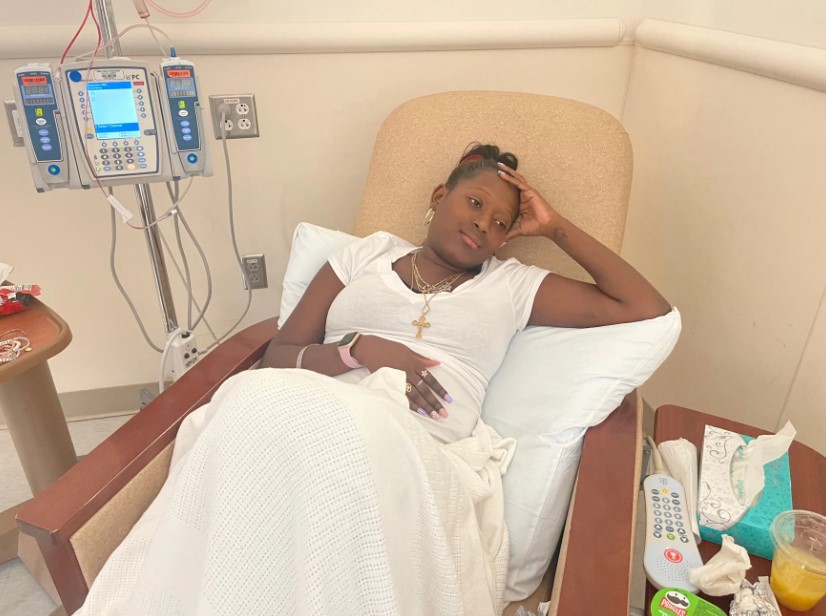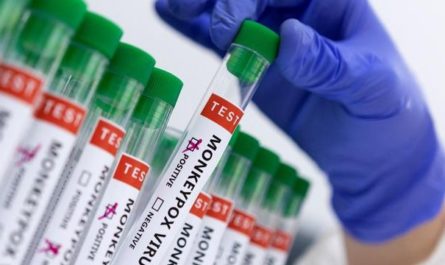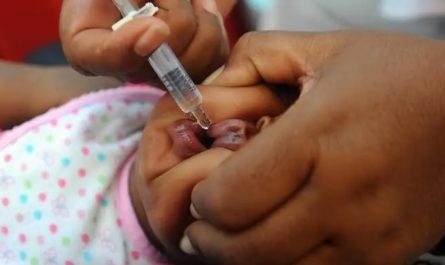Fredryanna Leonard is in a room of her own at the James P. Wilmot Cancer Center for her twice-a-month blood transfusions.
Just three hours into the process, she’s on her last of two units of blood.
“Usually, I’ll be here for like eight hours, but today feels pretty fast,” Leonard says, exhaustion in her voice.
Blood flows from an IV bag into a port installed in her chest. “The veins in my arms and my hands are all beat up or small from getting poked so many times,” she explains.
Leonard, 22, has sickle cell anemia and requires regular blood transfusions to replenish her red blood cells. For the last six years, she’s had transfusions almost every two weeks. The transfusions are hard, but they give her energy.
“I can always tell when I need one, I get extremely tired,” she says.
People with sickle cell produce irregular, sickle-shaped blood cells that can clog vessels and cause strokes. According to the American Society of Hematology, roughly 11% of sickle cell patients have strokes before the age of 20. Experts say that risk doubles by age 45.
Blood transfusions, though time-consuming, can prevent strokes and save lives. But they can also cause serious harm.
Doctors generally match blood type for donors, checking for A and B antigens and Rh factor, which is either present or not. Sickle cells complicate this further, because patients require the correct C, E and K antigens.
“We didn’t realize how toxic blood transfusions were,” says Dr. Neal Blumberg, the University of Rochester Medical Center’s director of transfusion medicine. “They have more side effects than we realized.”
Blumberg says transfusions act as a temporary organ transplant that can cause changes to the immune system. He says those changes may result in serious side effects if blood is not matched properly, particularly for sickle cell patients.
“With sickle cell patients, you have to come as close to the blood type as possible, including the antigens,” Blumberg says.
That’s why blood banks that care for sickle cell patients focus on C, E and K antigens, says Dr. Suzie Noronha, a pediatric oncologist at URMC’s Golisano Hospital who also treats sickle cell patients.
“The differences in those antigens cause the most problems,” she says.
Noronha has helped treat Leonard for her sickle cell disease for years. Like most people with sickle cell disease, Leonard is Black. Noronha says the antigens with shapes that are safe and effective for Leonard are typically only found in blood donated by African Americans, but most blood donors are white.
“That difference is enough, to where if the patient receives blood from a white donor, their immune system is going to recognize it as abnormal,” Noronha says.
According to data collected by the American Red Cross, before the COVID-19 pandemic, only about 4% of U.S. blood donors were Black.
As the district manager for Rochester’s Red Cross branch, Debra Dunn says just a slight increase in that number can drastically change the outcomes for sickle cell patients nationwide.
“If 250 Caucasians come through the door, we may find one who could support an African American or sickle cell donor with the appropriate antigens that we are looking for,” Dunn says. “If 250 African Americans come through the door, that number goes to 25 donors.”
Dunn has been working to get more African Americans to donate. She says the pandemic exposed long-standing disparities.
“With the impact that COVID had, it became very clear that in an emergency situation, our sickle cell patients would be at risk if we did not increase those numbers,” Dunn says.
Amber Young has been a blood donor for 22 years. She learned that she carried these specific antigens after the Red Cross started screening for them in September 2021.
“I’m a sickle cell fighter, which means that yes, my blood type matches,” Young says.
As a fighter, she donates whole blood only, which goes directly to sickle cell patients.
“I just found that fascinating,” she says. “You’re literally donating, like, life to somebody.”
It’s among the many ways she supports the Red Cross’s mission.
About eight years ago, Dunn hired Young to work for her at the local Red Cross. Under Dunn’s mentorship and training, when the director position opened up in Buffalo in July, Young secured the position.
Now just a little over a month into her new leadership role, the number of African Americans donating blood in that region has significantly increased. Last month, Young says she and her team collected 50 units of blood from Black people — more than the total from the whole of last year.
She says 30 of the units were from sickle cell fighters, and those donors will be receiving the same email that she did.
“I know we’re getting out into the community the way we should be,” Young says. “I just hope the community receives it well.”
Source: wxxinews



